
foreword | Historical Narratives | Resources | Links | Contact
MYSTERY MEMORIAL
History rests on evidence and other works surviving into the present.
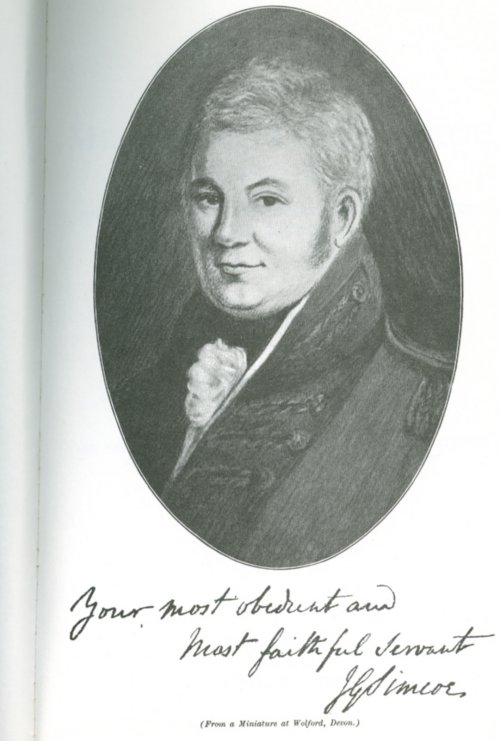 |
|
John Graves Simcoe |
Hitler's Heinkel bombers droned through the night, their destination Exeter, a city in southwestern England just a short flight from the Nazi bomber base across the Channel at Cherbourg, France. The German pilots were guided by the same moon that directed the Danes to England's shores a thousand years before.
 |
|
Heinkel Bomber |
Early in the morning of May 4th, 1942 the planes reached Exeter where they off-loaded their cargo of death and destruction. Exeter Cathedral, the main architectural and artistic feature of the city, received an indirect hit. Its St. James Chapel was destroyed and a huge hole was ripped in the aisle of the south choir. Unscathed just metres away was a memorial to a:
Maker of Canada
John Graves Simcoe.
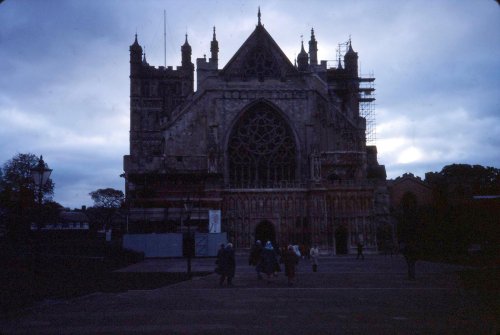 |
|
Exeter Cathedral |
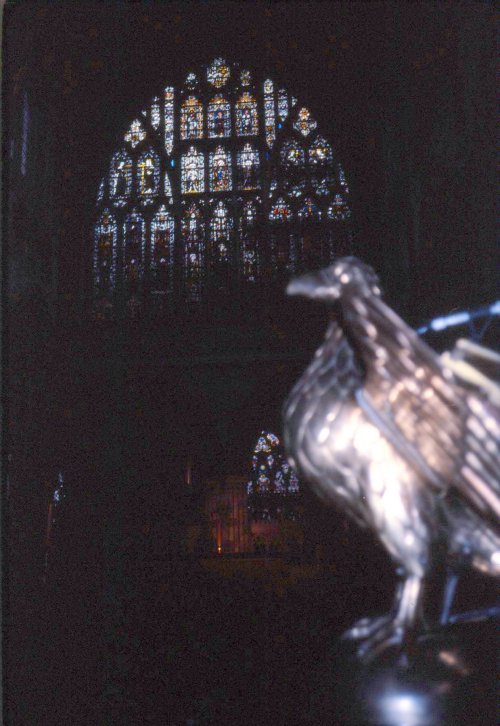 |
|
Altar of Exeter Cathedral |
 |
|
Simcoe's Memorial in Exeter Cathedral |
The following inscription adorns the monument above, a relief sculpture located on the wall off one of the aisles of Exeter Cathedral, which was executed by John Flaxman: Dedicated to Simcoe by the county of Devon, it commemorates his actions and accomplishments but makes no mention of his service and sacrifices in far-off Ontario.
Sacred to the Memory of
JOHN GRAVES SIMCOE
Lieutenant-General in the Army,
Colonel of the 22nd Regiment of Foot
Who died on the 25th day of October, 1806,
AGED 54 Years,
In whose life and character the Virtues of The Hero, The Patriot, and The Christian were so eminently conspicuous, that it may be justly said, he served his King and his Country with a zeal exceeded only by his piety toward God.
Only the figures that flank Simcoe's medallion portrait provide any clue to his work in the wilds of the new world. On Simcoe's left is the figure of a Aboriginal warrior; on his right a soldier of the Queen's Rangers.
The visitors' book at Exeter Cathedral attests to the fact that numerous Canadian tourists have visited this great cathedral. To each of these visitors, the tourist guide, as soon as she learns they are Canadians, undoubtedly mentions, as she did with us, that somewhere in the shadows of the cathedral, there is a memorial to, "someone who had something to do with your country." That someone is John Graves Simcoe.
To the English, Simcoe is an unknown name on the broad colourful canvas of British history. To Canadians, he is an important historical personage in Ontario's history. We are regularly reminded of Simcoe's significance, for his name graces a town and a county in the province and few of its cities do not have their Simcoe Street. Textbooks tout his character and courage and laud his singular contribution to our province's past.
Beautiful Lake Simcoe was named by Simcoe in honour of his father, John Simcoe, R,N., a naval officer. Both father and son served Canada. Captain Simcoe joined the 60-gun H.M.S.Pembroke in 1757 and in 1759 sailed for Canada as commander under James Cook, the master. In the same convey that carried Wolfe, John Simcoe died of pneumonia near the island of Anticosti on May 15, 1759 and was buried at sea.
After spending four of his 54 years in the Canadian wilderness, John Graves, Elizabeth and their children left Upper Canada on July 21st, 1796, never to return. Joyous was their welcome home at Wolford, where other daughters had anxiously waited their return. Simoce lost little time in making up for his absence. Much of the General's time and energy thereafter was thrown into the improvement of his estate. Up and about as early as six o'clock in the morning, Simcoe had much to do for little had been done during the years of his absence.
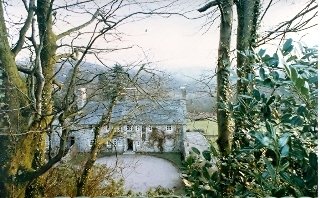 |
|
Simcoe's Wolford |
The man who firmly founded the great province of Ontario was not knighted for his dedicated service, receiving only the approbation of the sovereign he served so well. The king kindly expressed satisfaction with Simcoe's "unremitting zeal and assiduity". Faint praise some might say for the individual who so eagerly espoused the difficult task of settling his sovereign's distant colony in Canada. Simcoe gave in full measure of his enthusiasm, energy and effort in a determined, but foolishly futile attempt to make the North American colony "the very image and transcript of English society."
Simcoe was accompanied by his faithful wife, Elizabeth, whose myriad paintings documented every stage of their progress through the province and have left us with a wealth of wonderful watercolours documenting their life and times in our primitive province. These include the following paintings.
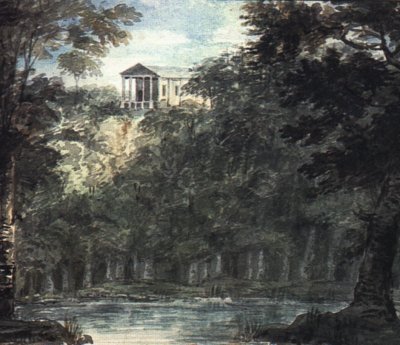 |
|
Castle Frank |
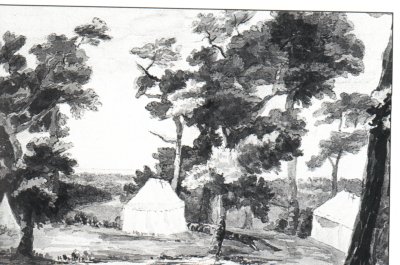 |
|
Simcoes' Tents at Newark |
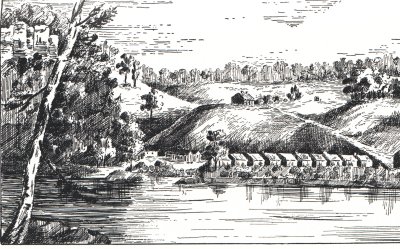 |
|
View of Queen's Rangers' Barracks, Queenston |
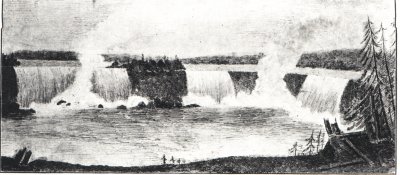 |
|
Niagara Falls from Canadian Side |
Elizabeth contributed to our artistic culture with her numerous paintings and to our historical record with words about life here in that long ago time. The pages of her diary, a daily record of life in the little, pioneer province, provide a fascinating glimpse of the civil and social life in Simcoe's "dream province." The first entry, dated Monday September 26, 1791, describes their departure for the New World from Weymouth. "Wind east, blowing fresh, fine and clear. It became calm this morning and at one o'clock p.m. we embarked on board His Majesty's the 29-gun frigate, Triton, piloted by Captain Murray."
Mrs. Simcoe's father also served in Canada. Her maiden name, Gwillim, is preserved in the township of Gwillimbury, a name that appears in both York and Simcoe counties. Mrs. Simcoe's father, Lieutenant-Colonel Thomas Gwillim, an aide-de-camp of General Wolfe, was with Wolfe when he died on the Plains of Abraham in 1759.
Of Simcoe's many services for his sovereign, one wonders what priority Simcoe would have assigned to his four years of activity and anguish in Upper Canada. How would he have rated his efforts and exploits here compared with his other official duties for the British Crown? The position as lieutenant governor of Upper Canada, which Simcoe compared to a species of banishment, was not his first choice. He eagerly sought appointment as the first British minister (ambassador) to the United States, a somewhat ironic preference given the derision and disdain he claimed to harbour for the young Republic.
During his service as an officer in the American Revolution, Simcoe was captured and confined as a prisoner for six months. His harsh, first-hand experience with what he called the excesses of republicanism, motivated his defensive measures during his tenure in the little Canadian colony. Subsequent to his service in Upper Canada, Simcoe was governor of Santo Domingo (Haiti) where he was charged with putting down an insurrection and pacifying the population. Later he was appointed military commander of the Western District in England at a time when a French invasion was feared.
Restless after spending three years restoring his health in England, Simcoe requested a foreign command and was appointed Commander-in-Chief of His Majesty's forces in India. Before he could depart to take up his new post, he was given a more urgent assignment. Napoleon was about to invade Portugal and Simcoe was one of three commissioners dispatched on a special mission to the Court of Portugal. On the voyage to Portugal Simcoe became ill and his sickness worsened so rapidly that he was immediately returned to Exeter in England. In the house of Archbishop Moore of Exeter Cathedral Simcoe died on Sunday, the 26th of October, 1806. He was buried in Wolford Chapel on the family estate. His wife, who died in 1850, and five of their eleven children were also interred there.
Upper Canada was a brief interlude in Simcoe's career but during the comparatively short time he was here he laid the foundations of Upper Canada. He proudly presided over the founding of this great province with this declaration.
In His own Words"It is our immediate duty to recommend our public acts to our fellow subjects by the efficacy of our private example and to contribute in this tract of the British Empire to form a nation, obedient to the laws, frugal, temperate, industrious, impressed with a steadfast love of justice, of honour, of public good, with unshaken probity and fortitude amongst all with Christian piety and gratitude to God."
Ontario remembers his labours and his legacy. On the first Monday in August Simcoe's memory is renewed each year. In 1998 the Ontario Legislature passed an amendment to the Municipal Act enacting that "If the head of the council of a local municipality proclaims the first Monday in August in any year as a civic holiday, the holiday shall be known as Simcoe Day." Toronto and several other cities have celebrated this day as Simcoe Day for years.
There is another less well-known provincial memorial to Simcoe. On September 27th, 1966 the Hon. John P. Robarts, Premier of Ontario, accepted on behalf of the people of the province the deed to the property on which Wolford Chapel is situated. The chapel was constructed in 1800 under the supervision of Simcoe himself following his return from Upper Canada. After years of neglect and decay - the building serving at its nadir as a stable - the chapel and site were adopted by Ontario. At the same ceremony of acceptance the owner of the former Simcoe estate also presented Premier Robarts with the deed of right-of-way to the chapel.
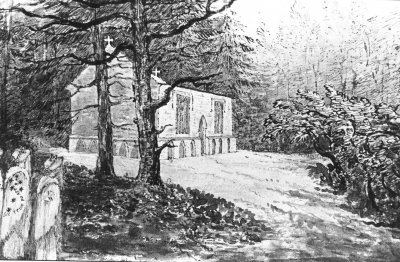 |
|
Wolford Chapel |
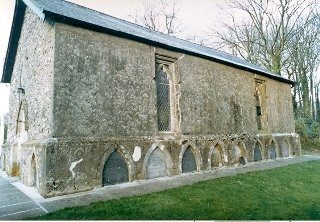 |
|
Photo of Wolford Chapel |
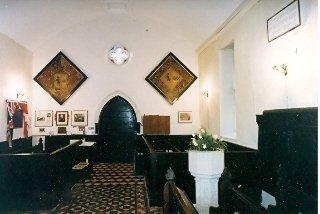 |
|
Inside Wolford Chapel |
Wolford Chapel in Devon in southwest England, the resting place of many of the Simcoes, has been completely restored and its upkeep and maintenance are the responsibility of Ontario. It has become a tiny piece of the province in the Sceptred Isle. One can only imagine Simcoe's amazement if he were to know that his family plot had become the property of the great, prosperous province of Ontario, successor to the tiny settlement he knew and nurtured so long ago.
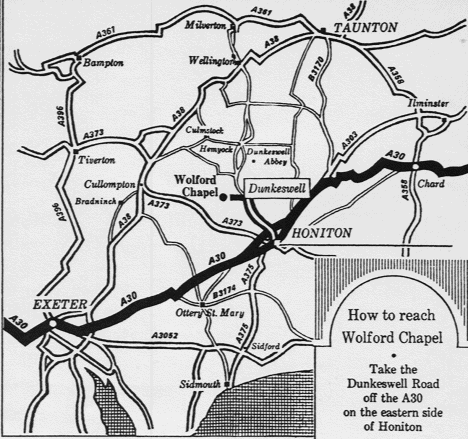 |
|
|
Copyright © 2013 Website Administrator